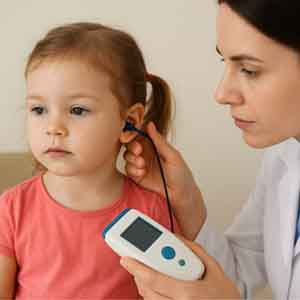What is OAE (otoacoustic emission) and how is it performed?
What OAE (Otoacoustic Emission) Testing Is
OAE hearing testing is a modern and non-invasive method for assessing the function of the auditory system, allowing detection of even minimal sound perception impairments. OAE (otoacoustic emission) is based on recording weak sound vibrations that occur within the cochlea of the inner ear in response to presented stimuli. These microscopic vibrations are captured by a special highly sensitive microphone placed in the ear canal and recorded by a device.
The otoacoustic emission method is considered an essential step in newborn hearing screening. The newborn hearing test allows early detection of possible hearing development issues and timely intervention. Thanks to its high accuracy and painless nature, this method is actively used not only in infants but also for hearing checks in older children.
The main advantage of the method is its ability to determine the functional state of the outer hair cells in the inner ear without complex procedures. OAE testing does not require active participation from the patient, making it ideal even for sleeping babies.
OAE is a primary yet highly informative test that helps audiologists determine whether a person can perceive sounds within the normal range and whether additional examinations, such as tympanometry or audiograms, are needed.
How the OAE Procedure Is Performed and How Long It Takes
OAE testing is completely painless and takes only a few minutes. The patient is positioned comfortably, usually sitting or lying down. A small probe equipped with a microphone and a miniature speaker is placed into the outer ear canal. Through this probe, short sound signals of specific frequencies are delivered to the ear, while the device records the corresponding sound waves generated in the cochlea.
The procedure is entirely safe and can be performed even on newborns. During the test, the child may sleep — this does not affect the results. The entire process takes 3 to 5 minutes, and the results appear on the device screen immediately after completion. Thus, the procedure duration is minimal, while accuracy is maximized.
Advantages of OAE testing:
-
Painless and comfortable — no intervention required;
-
High accuracy in detecting early hearing impairments;
-
Can be performed at any age;
-
Quick test interpretation and immediate results;
-
No preparation or special conditions needed.
How OAE Testing Is Conducted: Procedure Features and Recommendations
Before OAE testing, the doctor recommends ensuring that the ear canal is clean and free of earwax, as it may affect measurement accuracy. If the examination is performed on an infant, it is important that the child is calm or asleep. The device automatically delivers sound pulses and records the inner ear’s response.
After the test, the audiologist at the Hearing Center analyzes the graph showing the recorded sound responses. Normal cochlear function is indicated by a stable otoacoustic emission, signaling good hearing. If the response is absent or significantly reduced, further evaluation is recommended.
OAE testing is the first step in early detection of hearing impairments. This examination allows identification of hidden problems that may not yet be evident in a child’s behavior.
What Otoacoustic Emission Results Show and What They Mean
OAE hearing test results are displayed as a graph or digital report, showing the parameters of the inner ear’s response. The presence of a stable signal indicates normal auditory system function. In this case, the doctor concludes that hearing is within normal limits, and no further testing is required.
If the signal is absent or distorted, this may indicate cochlear dysfunction, earwax blockage, fluid in the middle ear, or other physiological conditions. However, the absence of a response does not always indicate hearing loss — the doctor may perform a repeat test or recommend more detailed diagnostics.
Test interpretation is carried out by a specialist at the Hearing Center, considering the patient’s age and ear canal condition. The final conclusion helps determine whether further monitoring or hearing correction is needed.
Thus, otoacoustic emission testing is a simple, fast, and safe method that provides a highly accurate assessment of inner ear function. Early hearing checks in children using OAE help detect potential problems promptly and support normal speech and auditory development.

















